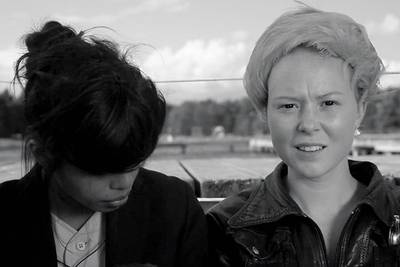
Among the various thematized screenings of individual films, the organizers of the Berlinale also created several exhibitions and forums to coincide with regular film screenings during the festival. These extra events seemed mostly to be an attempt to engage a wider audience interested in film that may only have been interested in the festival from a distance.
Forum Expanded is one of these attempts. In its seventh year, the forum hosted an exhibition series titled Critique and Clinic, introducing audience members to works and the artists that were not a part of the larger film competition that made up the rest of the Festival.
Exhibition I (of four) was held in Schöneberg at the Kunstsaele Berlin—an art gallery currently housed in what appeared to be a former apartment building, and what is now turned for the most part into offices.The space was quite large for a typical gallery space, with three separate screening rooms and one main exhibition room. However, despite the luxury of space, one could see from a central position in the main exhibition room up to five different screens at one time.
Arbeit, a documentary-style film by Duncan Campbell, whose main subject is Hans Tietmeyer, a German economist, was spliced from black and white archival material and was shown directly across from Iram Ghufran’s color semi-documentary, semi-mystical narration; a story of exiled Sufi women who are possessed by erotically-charged spiritual “dream-lovers”.
Of one of the women, “Kharar’s mother” her family says upon her disappearance that “she gave in to the temptations of the air.” Both films, despite their differences, had a similar clunkily-composed train of images that was further highlighted by fits and starts of narrative time.
The second half of the room was taken up by Virlani Hallberg and Jennifer Rainsford’s black and white, 2-panel film installation titled: O.G.B.I.P. (Our Global Behaviour is Pyschopathic II).
With different footage, both panels depicted the same characters and same story but at different times; where one panel zoomed in on the material quality of boating accoutrements, such as a boating line and bolts and waves, the other narrated the problematic interpersonal relationships between three women as they travelled together to an unknown destination on a sailboat.
The materiality of the film was emphasized by the installation of dual screens that could be viewed from either side, which reflected mainly grey and viscous-looking images, the only soundtrack—heard not only by viewers of the film but by all visitors to the gallery—being a shrill screaming match between the characters.
Passing through a velvet curtain to one of the individual screening rooms was quite a different experience. A large, empty and almost silent expanse was, in this case, the only obstacle separating individual viewers from the abstract—sometimes colourful, sometimes not—slowly-moving patterns of what appeared to mimic a scene from Star Wars: that suspended view of the bottom of the Millennium Falcon as is flies through outer space.
Anathema, is a film by The Otolith Group, which is the effort of several individuals from different countries, but was originally founded in 2002 by Anjalika Sagar and Kodwo Eshun and is currently based in the United Kingdom. The group is interested in collaborative artists’ projects that deal with the intersection between film, images and words.
Anathema does put on view the challenging relationship between similar categories and how they are represented through visual media. As they write on their website, much of the work of “the close reading of the image” that the Otolith Group strives to do does involve research, but, importantly, deals with information that is already accessible.
In Anathema, the abstracted and meandering images that make up the film are based mostly on a few short film clips. The drastically-changing attributes of the human body from male to female, or the small moving parts of organisms contained inside of a sort of Petri dish are due to, in this case, unspoken biological and technological processes that layer the atmosphere of the film.
These somewhat representational images that describe human affairs changed by the natural sciences are juxtaposed with abstracted images of themselves: where in one moment audience members see what are discernible as moving organisms, in the next a similarly-composed arrangement made up of animated blocks of color reference what one has just glimpsed.
In another case, viewers slowly apprehend a shot of deep space, composed of shapes that reference a computer’s motherboard and circuitry; in the next sequence, viewers get a glimpse of a similar image that changes only by virtue of the fact that lighter colours trace the details of the circuitry, as if the space is now imbued with electricity. Throughout the film, similar relationships are being made between what viewers see as an original that then becomes changed by way of film technique, altering our notion of what the image is over time.
The film also seems to self-consciously reference sound art of the 1960s, by using slowed-down and foggy-sounding compositions by John Cage and other sound experimenters as its soundtrack. Also used in the film are shortened recordings of narrated events by news reporters that have been edited to sound like stuttered voices that produce the sound of words without meaning.
Anathema, through all of its aesthetic pathways, gives viewers the sense of having seen a partial original, whose origin is ungraspable, but whose transition over time is seen as one of many potential processes of an image as it has changed.
And though we grasp the details of a specific moment in the image, the experience is most definitely temporary and groundless, albeit intense. In this way, the image functions for us more like a curse, or an anathema, where viewers are unable to identify a cause for what is there, but are compelled to work through that which surrounds them.
by Jaime Groetsema (AY ’12, USA)
